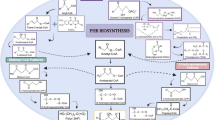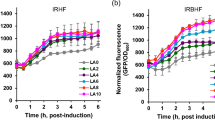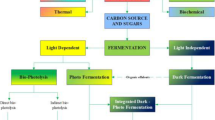Abstract
Microbiological synthesis of higher alcohols (1-butanol, isobutanol, 2-methyl-1-butanol, etc.) from plant biomass is critically important due to their advantages over ethanol as a motor fuel. In recent years, the use of branched-chain amino acid (BCAA) biosynthesis pathways together with heterologous Ehrlich pathway enzyme system (Hazelwood et al. in Appl Environ Microbiol 74:2259–2266, 2008) has been proposed by the Liao group as an alternative approach to aerobic production of higher alcohols as new-generation biofuels (Atsumi et al. in Nature 451:86–90, 2008; Atsumi et al. in Appl Microbiol Biotechnol 85:651–657, 2010; Cann and Liao in Appl Microbiol Biotechnol 81:89–98, 2008; Connor and Liao in Appl Environ Microbiol 74:5769–5775, 2008; Shen and Liao in Metab Eng 10:312–320, 2008; Yan and Liao in J Ind Microbiol Biotechnol 36:471–479, 2009). On the basis of these remarkable investigations, we re-engineered Escherichia coli valine-producing strain H-81, which possess overexpressed ilvGMED operon, for the aerobic conversion of sugar into isobutanol. To redirect valine biosynthesis to the production of alcohol, we also—as has been demonstrated previously (Atsumi et al. in Nature 451:86–90, 2008; Atsumi et al. in Appl Microbiol Biotechnol 85:651–657, 2010; Cann and Liao in Appl Microbiol Biotechnol 81:89–98, 2008; Connor and Liao in Appl Environ Microbiol 74:5769–5775, 2008; Shen and Liao in Metab Eng 10:312–320, 2008; Yan and Liao in J Ind Microbiol Biotechnol 36:471–479, 2009)—used enzymes of Ehrlich pathway. In particular, in our study, the following heterologous proteins were exploited: branched-chain 2-keto acid decarboxylase (BCKAD) encoded by the kdcA gene from Lactococcus lactis with rare codons substituted, and alcohol dehydrogenase (ADH) encoded by the ADH2 gene from Saccharomyces cerevisiae. We show that expression of both of these genes in the valine-producing strain H-81 results in accumulation of isobutanol instead of valine. Expression of BCKAD alone also resulted in isobutanol accumulation in the culture broth, supporting earlier obtained data (Atsumi et al. in Appl Microbiol Biotechnol 85:651–657, 2010) that native ADHs of E. coli are also capable of isobutanol production. Thus, in this work, isobutanol synthesis by E. coli was achieved using enzymes similar to but somewhat different from those previously used.



Similar content being viewed by others
References
Amberg D, Burke D, Strathern J (2005) Methods in yeast genetics, 2005th edn. Cold Spring Harbor Laboratory Course Manual, Cold Spring Harbor, NY
Atsumi S, Hanai T, Liao JC (2008) Non-fermentative pathways for synthesis of branched-chain higher alcohols as biofuels. Nature 451:86–90. doi:10.1038/nature06450
Atsumi S, Wu TY, Eckl EM, Hawkins SD, Buelter T, Liao JC (2010) Engineering the isobutanol biosynthetic pathway in Escherichia coli by comparison of three aldehyde reductase/alcohol dehydrogenase genes. Appl Microbiol Biotechnol 85:651–657. doi:10.1007/s00253-009-2085-6
Brynildsen MP, Liao JC (2009) An integrated network approach identifies the isobutanol response network of Escherichia coli. Mol Sys Biol 5:277. doi:10.1038/msb.2009.34
Cann AF, Liao JC (2008) Production of 2-methyl-1-butanol in engineered Escherichia coli. Appl Microbiol Biotechnol 81:89–98. doi:10.1007/s00253-008-1631-y
Collier RH, Kohlhaw G (1972) Nonidentity of the aspartate and the aromatic aminotransferase components of transaminase A in Escherichia coli. J Bacteriol 112:365–371
Connor MR, Liao JC (2008) Engineering of an Escherichia coli strain for the production of 3-methyl-1-butanol. Appl Environ Microbiol 74:5769–5775. doi:10.1128/AEM.00468-08
de la Plaza M, Fernandez de Palencia P, Pelaez C, Requena T (2004) Biochemical and molecular characterization of alphaketoisovalerate decarboxylase, an enzyme involved in the formation of aldehydes from amino acids by Lactococcus lactis. FEMS Microbiol Lett 238:367–374. doi:10.1016/j.femsle.2004.07.057
de Smidt O, du Preez JC, Albertyn J (2008) The alcohol dehydrogenases of Saccharomyces cerevisiae: a comprehensive review. FEMS Yeast Res 8:967–978. doi:10.1111/j.1567-1364.2008.00387
Dickinson JR, Harrison SJ, Hewlins MJE (1998) An investigation of the metabolism of valine to isobutyl alcohol in Saccharomyces cerevisiae. J Biol Chem 273:25751–25756. doi:10.1074/jbc.273.40.25751
Dickinson JR, Harrison SJ, Dickinson JA, Hewlins MJE (2000) An investigation of the metabolism of isoleucine to active amyl alcohol in Saccharomyces cerevisiae. J Biol Chem 275:10937–10942. doi:10.1074/jbc.275.15.10937
Dickinson JR, Salgado LEJ, Hewlins MJE (2003) The catabolism of amino acids to long chain and complex alcohols in Saccharomyces cerevisiae. J Biol Chem 278:8028–8034. doi:10.1074/jbc.M211914200
Hazelwood LA, Daran JM, van Maris AJA, Pronk JT, Dickinson JR (2008) The Ehrlich pathway for fusel alcohol production: a century of research on Saccharomyces cerevisiae metabolism. Appl Environ Microbiol 74:2259–2266. doi:10.1128/AEM.02625-07
Keseler IM, Bonavides-Martinez C, Collado-Vides J, Gama-Castro S, Gunsalus RP, Johnson DA, Krummenacker M, Nolan LM, Paley S, Paulsen IT, Peralta-Gil M, Santos-Zavaleta A, Shearer AG, Karp PD (2009) EcoCyc: A comprehensive view of Escherichia coli biology. Nucleic Acids Res 37:D464–D470. doi:10.1093/nar/gkn751
Knoshaug EP, Zhang M (2009) Butanol tolerance in a selection of microorganisms. Appl Biochem Biotechnol 153:13–20. doi:10.1007/s12010-008-8460-4
Lin YL, Blaschek HP (1983) Butanol production by a butanol-tolerant strain of Clostridium acetobutylicum in extruded corn broth. Appl Environ Microbiol 45:966–973
Luo LH, Seo PS, Seo JW, Heo SY, Kim DH, Kim CH (2009) Improved ethanol tolerance in Escherichia coli by changing the cellular fatty acids composition through genetic manipulation. Biotechnol Lett 31:1867–1871. doi:10.1007/s10529-009-0092-4
Nair RV, Bennett GN, Papoutsakis ET (1994) Molecular characterization of an aldehyde/alcohol dehydrogenase gene from Clostridium acetobutylicum ATCC 824. J Bacteriol 176:871–885
Ptashne M (1986) A genetic switch: gene control and phage λ. Cell Press & Blackwell Scientific, Oxford
Sambrook J, Russell D (2001) Molecular cloning: a laboratory manual, 3rd edn. Cold Spring Harbor Laboratory Press, Cold Spring Harbor
Savrasova EA (2007) Development of the mini-Mu system for highly effective integration and amplification of genetic material into the chromosome of E. coli without selective marker. Ph.D. Thesis, Moscow
Sentheshanuganathan S (1960) The mechanism of the formation of higher alcohols from amino acids by Saccharomyces cerevisiae. Biochem J 74:568–576
Shen CR, Liao JC (2008) Metabolic engineering of Escherichia coli for 1-butanol and 1-propanol production via the keto-acid pathways. Metab Eng 10:312–320. doi:10.1016/j.ymben.2008.08.001
Smit BA, van Hylckama Vlieg JET, Engels WJM, Meijer L, Wouters JTM, Smit G (2005) Identification, cloning, and characterization of a Lactococcus lactis branched-chain α-keto acid decarboxylase involved in flavor formation. Appl Environ Microbiol 71:303–311. doi:10.1128/AEM.71.1.303-311.2005
Sulzenbacher G, Alvarez K, Van Den Heuvel RH, Versluis C, Spinelli S, Campanacci V, Valencia C, Cambillau C, Eklund H, Tegoni M (2004) Crystal structure of E. coli alcohol dehydrogenase YqhD: evidence of a covalently modified NADP coenzyme. J Mol Biol 342:489–502. doi:10.1016/j.jmb.2004.07.034
Tabolina E, Rybak K, Khourges E, Voroshilova E, Gusyatiner M (2005) Method for producing L-amino acid using bacteria belonging to the genus Escherichia. US Patent 7476531
Yan Y, Liao JC (2009) Engineering metabolic systems for production of advanced fuels. J Ind Microbiol Biotechnol 36:471–479. doi:10.1007/s10295-009-0532-0
Yep A, Kenyon GL, McLeish MJ (2006) Determinants of substrate specificity in KdcA, a thiamin diphosphate-dependent decarboxylase. Bioorg Chem 34:325–336. doi:10.1016/j.bioorg.2006.08.005
Author information
Authors and Affiliations
Corresponding authors
Rights and permissions
About this article
Cite this article
Savrasova, E.A., Kivero, A.D., Shakulov, R.S. et al. Use of the valine biosynthetic pathway to convert glucose into isobutanol. J Ind Microbiol Biotechnol 38, 1287–1294 (2011). https://doi.org/10.1007/s10295-010-0907-2
Received:
Accepted:
Published:
Issue Date:
DOI: https://doi.org/10.1007/s10295-010-0907-2




